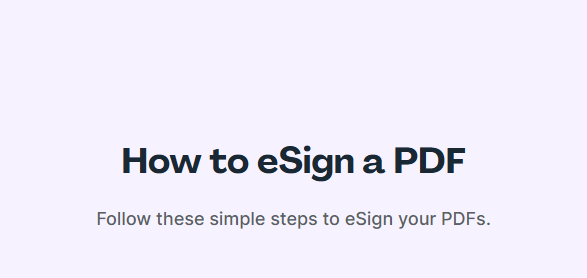Potent PDF Electronic Signatures: The Way to Sign Files on the Internet
Whenever hackers hack into the systems of a company, they often steal the credentials of the company officials to make fraudulent transactions. This, however, is avoidable in case you employ advanced levels of security in documents made possible through eSign APIs. eSigns offer a secure method by which digital documents are verified using cryptographic algorithms, MFAs, and even timestamping to discourage alterations that are unauthorized alterations and conform to legalities.
This blog is going to discuss the more sophisticated aspect of electronic signatures within PDF documents, along with the ability to safely sign documents online. You will also get to know how the tools safeguard your files against tampering and fraud, making the online transactions safe for the concerned parties.
Advanced features of eSign API for PDF Signatures
eSign API protects online transactions using many enhanced and tailored eSign electronic signature options.
Multi-factor authentication (MFA) for signatories
Significance of multi-factor authentication
Increased security: The MFAs will increase security on digital assets by adding additional safety to the assets, compared to that associated with using passwords, by 99.9 percent.
Low risk: The chances of identity theft and cyber attacks would be reduced considerably because multiple verification forms are required.
· Compliance: Implementing industries such as finance and healthcare regulatory requirements for the strict and robust authentication methods, such as MFA.
An example of how eSign API uses multi-factor authentication
· Optional verification techniques: A business using an eSign API can select a type of method of verification method, such as SMS codes, email authentication, biometrics, or a bilateral miniature token.
· Flexibility of integration: An eSign API can easily be integrated with MFA in the form of a PDF document or web applications or mobile applications, or third-party platforms.
· Audit trails: that offer transparency in the authentication process through thorough logs and audit trails built in, businesses can track, authenticate, and monitor all signature activities.
Custom signature fields
Creating custom signature fields in PDFs
Personalization: Customize the field of sign potential with distinctive markers like names, titles, or, if necessary, one or more dates, providing clarity and context to signatories.
Configuring field properties for enhanced security
· Encryption: Use encryption in signature fields, which ensures files are kept secure so that non-authorised persons do not access those files.
Access control: Apply restrictions to signature fields so that only editing or viewing rights can be allowed.
Validation: Set signature fields so that they have to follow certain standards, such as minimum character length or pattern checks.
Audit trails: Build a system of tracking the activities in the custom field, since it is a key requirement in terms of accountability and transparency.
Automated signature workflow
Automated workflows make online signing of documents more convenient as it does not require any time or manual effort:
Setting up automated workflows for signatures
Customization of workflow: The signing process can be customized to suit the requirements of your business, e.g., to perform simple approvals or to support complex multi-party transactions.
· Trigger events: specify the conditions under which signature requests can be automatically triggered. This may include document upload, form submission, and certain dates.
Role-based assignments: It involves assigning signing roles to the users according to their profiles, or organizational structures. This will help the required persons sign PDFs at the appropriate time.
· Integration: Integrate automated workflows effortlessly into your PDFs, CRM, or project management systems.
Benefits of automated workflows in document management
Efficiency: It accelerates the speed of document processing and document turnaround time with minimal manual interventions.
· Precision and conformity: Standardization of the processes will assist to eliminate errors and it promotes consistency in processing documents. This reduces the probability of violation of the regulations or data leak.
· Visibility and transparency: It creates document status and progress visibility in real-time. It implies that stakeholders will simply trace and monitor signings.
· Cost and savings of time: By saving manual work, there is a savings of time as well as operational costs relating to the management of documents. As possible, savings per employee per year companies can use $14,000.
Bulk signing features
The bulk signing option provided by the eSign API allows one to sign a bunch of documents online simultaneously.
How to implement bulk signing with eSign API
· Batch processing: It allows uploading a range of documents within a single operation and starting the signing process.
· Template-based signing: There is also template-based signing, so that most often-signed documents can be made into reusable templates to make the bulk signing of documents online.
· Automated distribution: Enumerate the recipients of the different documents and how they are to sign them, so that there is no problem during the whole process.
· Status checking: Check the signing progress of all the documents in real time to have the transactions managed and followed easily.
Use cases for bulk signing
HR onboarding: Collectively sign employment contracts, NDAs, and other HR documents for the new hires.
· Legal contracts: Bulk sign legal contracts, leases, and agreements with clients or vendors.
· Financial transaction: Transact several invoices, purchase orders, and financial reports at once to enhance efficiency.
·Regulatory compliance: Sign the bulk PDFs that are required to meet industry regulations, perform audits, certifications, and disclosures.
Time-stamped signatures:
Electronic PDFs are also kept safe and authentic with the help of timestamps.
Importance of time stamping in legal and compliance contexts
· Legal acceptability: Using time-stamping makes the document legally valid since there is concrete evidence of the signatures of the documents and the date and time at which it is signed. This is to ensure the credibility in court.
· Compliance needs: Compliance needs require time-stamping to satisfy the regulations in many industries and select accountability in audit trials.
How eSign API facilitates time-stamped signatures
· Automated time-stamping: An eSign API is automatic in organization of time-stamps when signing a document, which saves time used manually and is accurate.
· Cryptographic security: The API has cryptographic methods of time stamping online e-signatures and preventing tampering or tampering safely.
Integrating advanced signature features into your system
The incorporation of powerful signature options into your working processes is essential in terms of document security and compliance in the current world.
Overview of integration options with eSign API
· SDKs and libraries: Utilize the libraries and SDKs of eSign API to find simplification of integration in different programming languages and platforms.
· API Integration: Integrate the eSign API into your PDFs, existing applications, or systems to include additional features of signature features in them.
· Webhooks and callbacks: The callbacks and webhooks will provide instant updates and notifications of such critical signature events, enhance automation of workflows, and the user experience.
Step-by-step guide to integrating advanced features
1. Authentication: Make sure you authenticate your application to the eSign API through secure authentication protocols, including OAuth 2.0.
2. Configuration of the signature fields: Configure the signature fields the way you need them. This encompasses properties at the field level to include encryption, access control, and validation.
3. MFA config: Implement MFA on signatories, and ensure that at least one verification factor apart from passwords by use of passwords.
4. Automated configuration of workflows: Limit the configuration of workflows to your document signing processes. Identify trigger events, role assignments, and recipient management.
5. Timestamp signing signature integrity: Integrate time-stamped signatures on documents to keep them safe and verify their authenticity, and comply with regulatory and lawful requirements.
Conclusion
The electronic signatures features in PDF including eSign API are efficient and provide high security concerning digital transactions. Having a multi-level authentication process in place, custom signature blocks, automated workflows, batch signing, time-stamped signatures, businesses are capable of making document integrity, compliance, and other more efficient processes, making overall operations better.








